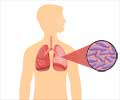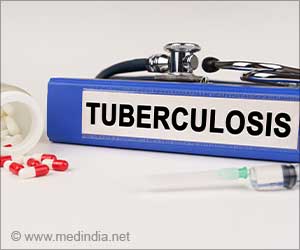WHO Global Ministerial Conference was heald to end TB (Tuberculosis) by 2030. End TB Strategy aims to end TB with the Sustainable development goals (SDGs).

‘Tuberculosis (TB) can be eliminated by improving health care, social protection, poverty alleviation, poor living conditions and malnutrition.’





While we hope this pivotal meeting will spur the fight against TB to levels warranted in order to bring the world back on track to #endTB by 2030, it is prudent to listen to the person who headed the WHO Global TB Programme, one of the key organizers of this historic meet in Russia: Dr Mario Raviglione. Especially, when soon after this meeting, he superannuated from the WHO, passing on the baton of the WHO Global TB Programme to Dr Tereza Kasaeva who was also a part of the team behind the Russia meet.Dr Mario Raviglione, retired from the WHO after 26 years of yeoman service, 14 years of which were as the Director. He gave an exclusive interview to CNS Managing Editor Shobha Shukla, the highlights of which are as follows:
From hoping to pursue cardiology, to spearheading the global fight against TB, must have been a leap of faith for you back then 30 years ago. Has this journey been a bed of roses or a throne of thorns for you?
Dr Mario Raviglione: "This, indeed, has been a very long journey. When I joined WHO as a junior professional officer (JPO) in 1991, the environment for TB was nowhere as dynamic as the one I was seeing in the HIV/AIDS world where I had been hitherto working. Back then I thought I was going to get bored with TB. But it soon proved to be otherwise. In the following few months grew my understanding that TB was a major killer. Being an HIV/AIDS doctor, I had not realised this fully, even though I had been in New York and Boston where TB and HIV were already converging, especially in the poor and marginalised homeless people and poor immigrants.
During the next few years I had the fortune of being part of an evolving programme of TB at WHO that, for the first time, created the concept of the simple essentials of TB control, called the DOTS strategy. No other programme was going in that direction, making it simple and branding it with a captivating acronym. Those leading TB control at WHO in the 1990s were visionary people. At that time, 20 years ago, there was no database on TB.
Advertisement
I began to understand the whole variety of determinants of this disease that went well beyond HIV. Only 10% of the global TB burden is related to HIV, and the remaining 90% is because of issues like poverty, lack of social protection, malnutrition, tobacco, diabetes, cramped housing, etc. All these made TB a model disease of poverty that needed a multi-sectoral and multidisciplinary approach to fight it.
Please share some of the milestones you achieved in this fight against TB during your tenure at WHO?
Dr Mario Raviglione: "Even before I became Director of the WHO Global TB Programme, an important milestone and achievement for me was to help put in place an essential DOTS strategy at a time when there was therapeutic 'anarchy' in the TB world. At that time, there was absolute chaos - no one knew who was doing what; there were no data, and no standards in diagnosis and treatment. And all this 'anarchy' is probably the main cause for generating a lot of MDR-TB that we are seeing today.
DOTS tried to fix all this up with a very simple message. Yes, the strategy was misinterpreted being taken as mere supervision of TB treatment. But actually DOTS goes much beyond that - it is about the way you diagnose, the way you report, the way you treat, the way you have a drug supply system in place. It was a simplified but essential strategy that guided the world in the face of no standard.
All the elements of DOTS strategy are very much in place today, they have just been modernized, with better technologies to implement them. We have molecular diagnostics in place of microscopy, shorter treatment regimens for MDR-TB, and electronic tools for monitoring (which must be made available even at the lowest level of healthcare).
Among my other achievements in the 1990s I would just mention:- setting up a monitoring system which gave us the information to understand that TB is a major issue, and in which countries/regions it is a major issue, and putting up a global drug resistance surveillance (DRS) project in place.
It is thanks to the DRS system that we could understand in the late 1990s the extent of the problem, previously denied, and addressing it by negotiating drug prices with the industry, and setting up mechanisms to provide access while ensuring care was of the highest standards to cure the person and prevent misuse and further resistance.
After I became the Director in 2003, several things happened:
- Immediate modernization of the DOTS strategy to address emerging challenges
- Prioritization of TB-HIV collaboration with a new set of joint policies between these two often parallel programs
- Further focus on MDR-TB, and
- Prioritization of research
In 2010, I saw for the first time, in my career, real innovations - a new molecular diagnostic tool GeneXpert, and two new drugs (Bedaquiline and Delamanid). GeneXpert is now being used in most countries, and more are following suit. GeneXpert can do what was unthinkable 10 years ago - test the presence of TB and simultaneously drug resistant TB within 2 hours, thus allowing the patient to be put on proper treatment from day one. This is a major achievement, even though we have to go well beyond this to have a point-of-care test.
The introduction of shorter MDR-TB regimens after a proper assessment of their effectiveness in the field and the guidance on the correct use of 2 new drugs after only phase 2B studies (following the highest scientific standards possible with imperfect and incomplete data) also came as major innovations in my long journey. This is a sensitive issue, and what we did was keeping the interest of the affected people in mind saving their lives without putting them at risk of adverse effects.
Then we worked on child friendly formulations for paediatric TB - a tasty syrup instead of having to break the unpalatable adult pills to give to kids. It was a very simple concept, but took years to develop because no drug company seemed interested and there was no money. Then some funders, like UNITAID, came forward, and put money in the right place. So we now finally have the fixed dose combination of child friendly formulations for kids.
Next came the recognition of the need to engage with the Sustainable development goals (SDGs). WHO's post-2015 End TB Strategy, formulated in 2014, aims to end the global TB epidemic in consonance with the SDGs. Ending TB is not just a public health problem, but a development challenge. TB is a classical disease of poverty, around which one can build linkages with the targets of different SDGs.
Eliminating TB will require not just improvements in healthcare but also in the context of social protection, poverty alleviation, malnutrition, poor living conditions, etc. We have focused on the influencers of TB to show that TB is at the centre of SDGs. Hence achievements in other SDGs are also going to influence the TB epidemic. We have also focused on promoting person-centred care, ethical standards and human right-based approaches. I am proud of having worked with colleagues who truly believed in these principles and defined them well in a world full of xenophobia, racism and inequalities.
Among milestones, I cannot forget having engaged civil society and community and patient representatives in our WHO work. I am happy to say that there is not a single advisory committee or governing body in TB that does not include representatives of affected communities and civil society. This, which I inherited from the HIV/AIDS world of the 1980s from which I originally came, I consider an area in need of further expansion. We need the people we serve to tell us what the right direction is.
We have set up a Task Force based on democratic selection of people as members. This to me is per se a great achievement, as we need constituencies to be formed everywhere and proper selection of people to sit in our policy-making bodies. This will make them credible and powerful.
And finally, at the end of my WHO career, we are talking about accountability. In Moscow this came up clearly, after we started at WHO to conceive the idea earlier this year. Accountability is a mechanism that, if well done, will not allow much excuses for insufficient or wrong doing. All these are milestones for me."
How important is it to tackle the current reservoir of latent TB?
Dr. Mario Raviglione: "Latent TB is indeed a big issue. When I joined WHO, the first thing I did was to put together in January 1992, a meeting on preventive therapy. And the recommendation was to use it for prevention of TB in people living with HIV (PLHIV). But the recommendation could not be implemented widely as, despite growing evidence, it was opposed by many people and important technical agencies. At that time the TB community was against the use of prophylaxis. Theirs was a minimalist attitude, wanting to first take care of people with TB, and then think of prophylaxis, as it seemed there was not enough money for both. This was very different from the HIV community who insisted to put in more money if there was less of it.
TB has never had that sort of activism, not even today. So, chemo-prophylaxis for PLHIV at risk of TB was left to individual doctors’ decision, instead of becoming part of the TB programmes. In 1998 another set of recommendations was made jointly with UNAIDS that promoted use of prophylaxis in PLHIV. But getting isoniazid (INH) preventive therapy from national TB programmes (NTPs) was very difficult because some were adamantly opposing it. The notion was that if INH is given by mistake to someone with TB it will create resistance. The conservative thinking in TB care has been truly detrimental and, at times, a real obstacle to progress.
When I took over as Director, we realised that we had to intensify efforts and target this pool of people with latent TB, else there could be millions of new TB cases and deaths from that pool. Eventually WHO came out with solid and unquestionable evidence-based latent infection recommendations that PLHIV and children below 5 years of age, and some other high risk groups were to be given prophylaxis.
Now, new guidelines are expected to come out very soon that extend treatment of latent TB to all contacts, irrespective of their age. Today, we have a better prophylaxis regimen - giving Rifapentine with Isoniazid once a week for 3 months. Discussions are going on with pharmaceutical companies to make available enough of Rifapentine so that it could be accessed more widely. I call it criminal not to have enough of this potentially lifesaving drug. We need activism here: the constructive one and the one that is targeting the right targets."
What about infection control in healthcare facilities?
Dr. Mario Raviglione: "Infection control is part of the development of health systems in general. Health systems that do not have proper infection control methods in place are going to generate more TB cases. We are being stupid if we think that we can control TB without taking care of the basics like proper infection control. In most of the poor countries we do not find proper infection control strategies in place in hospitals and care facilities. This is a fact: solutions belong to ministers and not the TB programme managers. It is a system failure."
Your take on TB-diabetes co-infection?
Dr. Mario Raviglione: "All TB patients must be tested for diabetes and a diabetes patient should be asked about any TB symptoms like cough etc. This should prompt investigations as needed. A high index of suspicion is necessary to detect TB as early as possible. A global recommendation for giving TB prophylaxis to all people with diabetes is ruled out at the moment for lack of evidence. But linkages between the two in primary healthcare facilities and/or in diabetes clinics are crucial. This again reinforces the need for infection control in diabetes clinics and in HIV centres."
How important is universal drug susceptibility test (DST)?
Dr. Mario Raviglione: "I call it a clinical malpractice if we do not do it. Often the mentality of TB has been dominated by non-infectious disease doctors who do not understand the importance of DST. One has to reason out as an infectious disease specialist to promote DST - get the culture done and find out to what medicines the disease is sensitive or resistant to.
In the TB field this was not practiced. It felt cumbersome to wait for 2-3 months before getting the culture results, as meanwhile the patient might already be dead or gone worse. But today we have new technologies, like the GeneXpert and Line Probe Assay, that can detect drug resistance very quickly. So now there can be no excuse whatsoever. Doing DST of the sputum upfront should be made mandatory. TB is an infectious disease and you need to know its antibiogram. Else it is like treating the disease blindly."
Please share some of the challenges you faced in putting up this Ministerial Conference in Moscow- your grand finale milestone in your battle against TB?
Dr. Mario Raviglione: "We wanted to make sure that people understood that we are advocating for a multi-sectoral approach. Such an approach requires involvement of sectors and ministers of health as well as those not dealing directly with health. WHO supported 2 delegates from each of the 40 high TB burden countries, requesting them to send their minister of health and one more representative. But we have here very few ministers from non-health departments. It is still some start.
We also have here other UN agencies that are working in different sectors, like UNDP, IOM, OIE (Agriculture). We should achieve a consensus on key issues amongst those who are here to allow us to build a proper argument during the UNGA, that is just 10 months away. The Moscow Declaration will inform the WHO executive board at the World Health Assembly (WHA) where hopefully there will be resolutions to implement the recommendations made in the Moscow Declaration.
At the same time, it will be in parallel with the development of a declaration in the UN General Assembly (UNGA) preparation. That will automatically be in the hands of ministers of foreign affairs. So hopefully they will not limit themselves to ministers of health, but talk to other ministers as well like those of finance, social welfare etc. Of course ultimately we need the heads of the countries to show leadership in directing these operations. Other ministries need to be sensitized to do what needs to be done to benefit health in general and also TB patients.
The hope is that starting from this Moscow meeting, we are able to mobilize through this mechanism that will take us to UNGA. It would be difficult for WHO alone to involve other ministries. We want the World Bank to make finance ministers understand that TB is an economic issue as well. At UNGA, the target date is the ‘week of the leaders’ taking place in the 3rd week of September in New York. This will again depend upon member states.
So we hope that at least some of ministers of health can go back from Moscow and convince their Heads of State to in turn convince their UN missions in NY that this UN High Level Meeting (HLM) on TB takes place during the ‘week of the leaders’. If it takes place some other time, when no one is there, then we fail. This is going to be a testing time for the entire TB community. It will not be easy. Hopefully, this conference will create a momentum and the unity that is necessary to allow us to get there."
Your message as we look ahead?
Dr. Mario Raviglione: "There is no magic bullet for TB today. Do not believe those who come and tell you that we can do miracles. We simply have to optimize use of the tools we currently have, while investing now for better tools to come. So funding research is crucial. We need 10 times more budget than the current USD 700 million investment for TB, if we really want to see new tools coming in.
US based National Institutes of Health [NIH], the number one funder of TB in the world - invests USD 260 million, while it invests 12 times more - about USD 3 billion - in HIV/AIDS. We need much more money to attract the best minds and the best centers for research. Else, the progress will be as slow as it has been so far. Also, there is need for countries to rely increasingly on domestic funding to make TB control activities sustainable and part of the fundamental country budgets that is non-negotiable."
Your message to your successor?
Dr. Mario Raviglione: "I would like to say:
- Pursue the lines we took in Moscow, promoting universal access to TB care and control and keep guiding the world with evidence-based science and rigor;
- Advocate incessantly for sustainable financing and research. Build the case in the context of Universal Health Coverage (UHC) and Anti-Microbial Resistance (AMR) agendas. Remind the world that it is not just the international donors that should put in money, but middle income countries, where most of the TB cases are, must invest much more; and
- Pursue accountability. Earlier we did not have the power to do it. But now, between the Moscow Declaration and the UNGA, we have the possibility of establishing serious accountability systems, where all those involved in this struggle from governments to donors to international agencies can be monitored for what they do right and wrong."
Dr Mario Raviglione: "They are not well defined yet. I could go catching butterflies, for all that I know. Jokes apart, I would like to disseminate what I have learned in all these years. People like me, who have had the fortune of working at an international organization like the WHO, have a lot to say from personal experiences, on health diplomacy and health governance other than what is written in the books, and the science we have nurtured and contributed to. And I will always keep my eyes on TB. I cannot avoid it."
Source-Citizen News Service (CNS)













